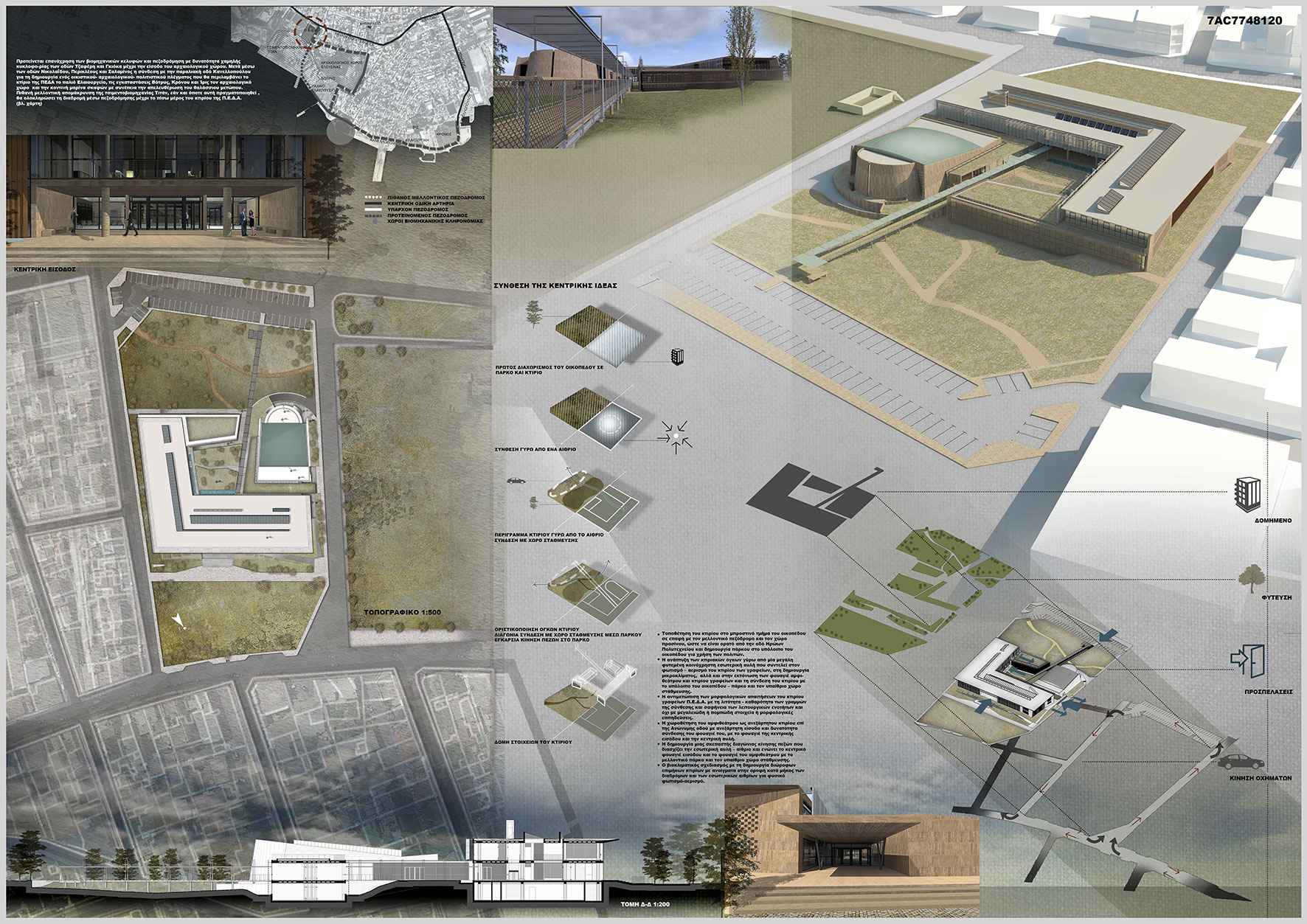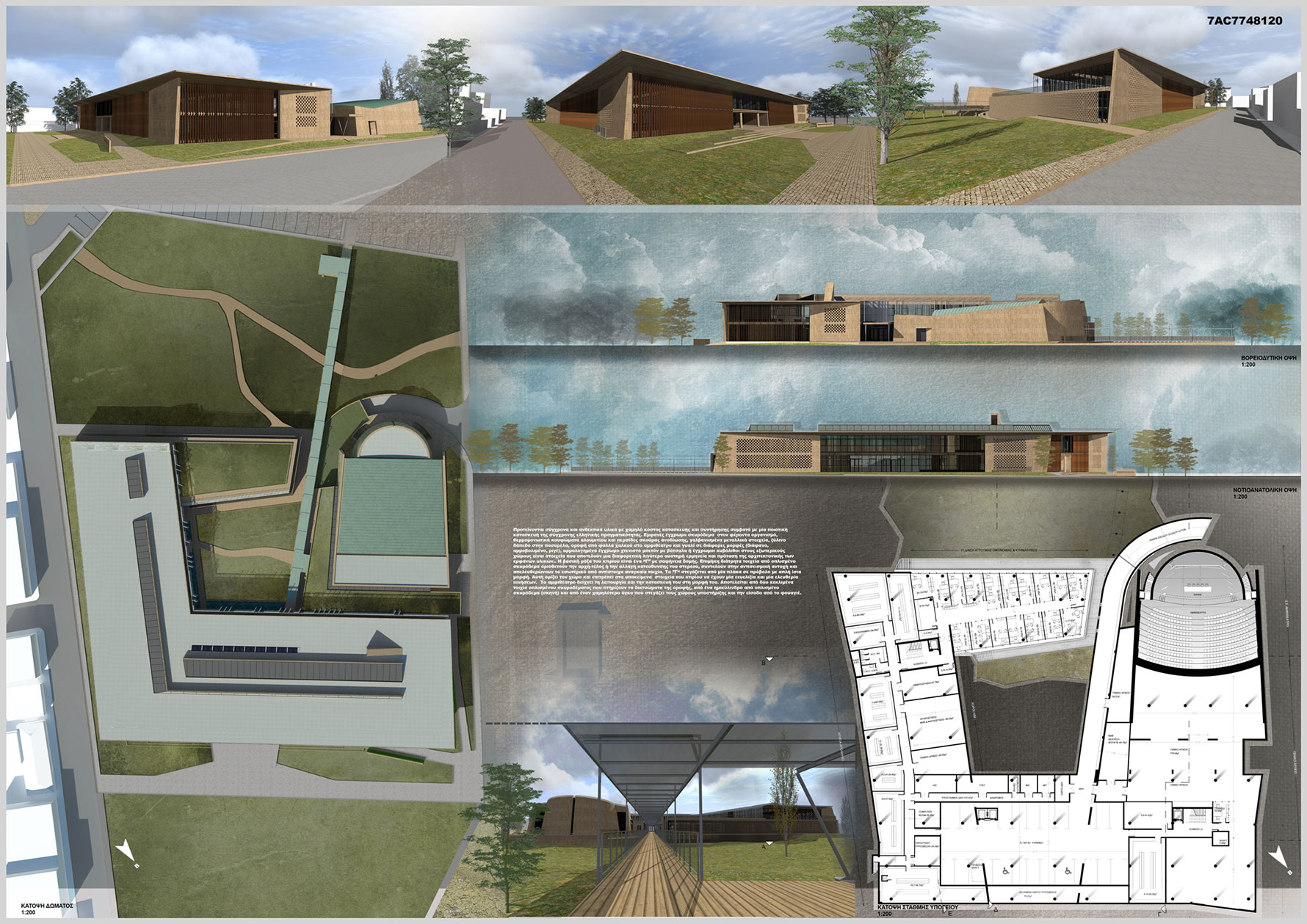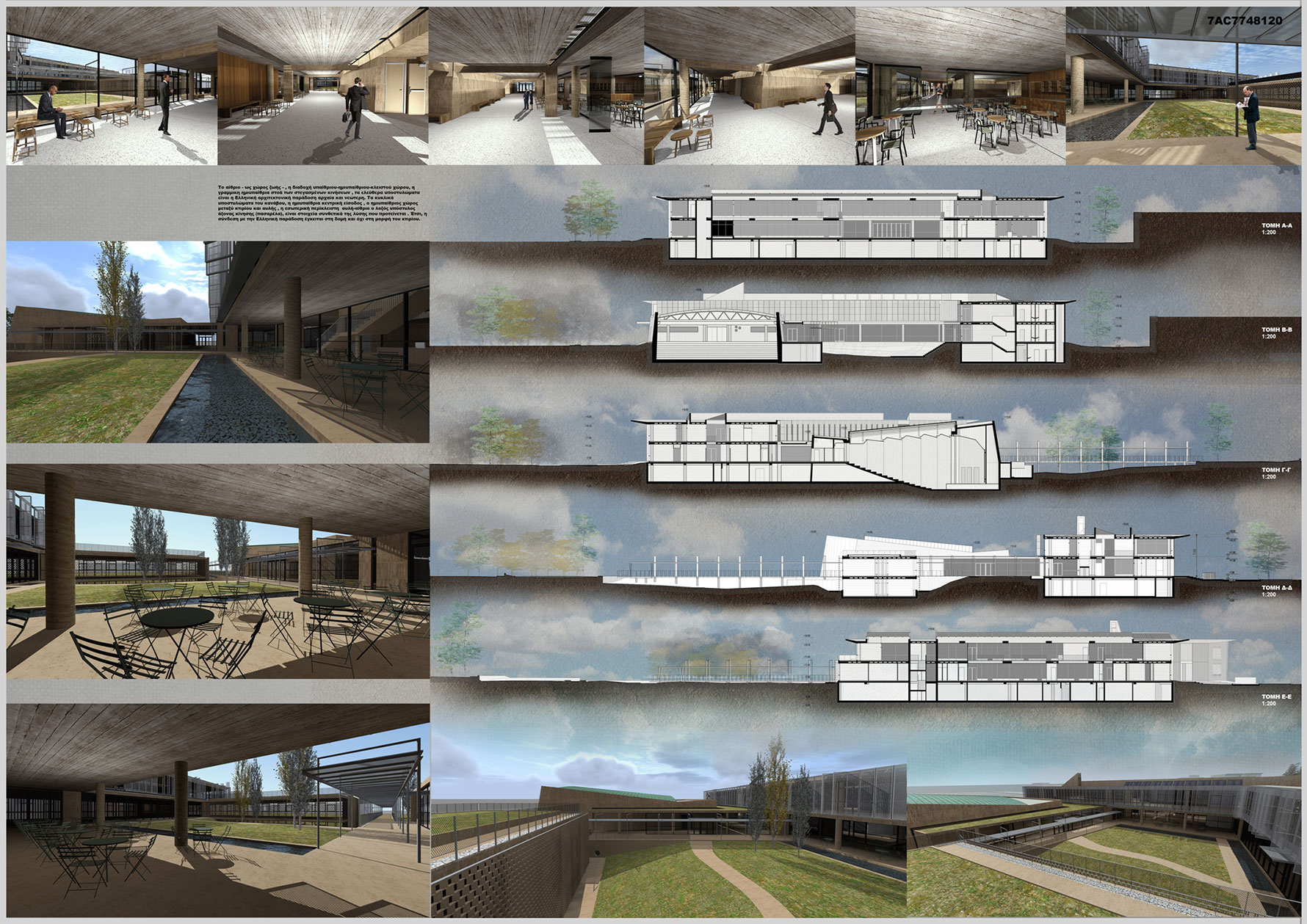COMPETITION
ARCHITECTURAL COMPETITION FOR THE CONSTRUCTION OF THE P.E.D.A BUILDING IN ELEFSINA
Location: Block 257, Elefsina, Attica
Study: 2018
PROJECT CREDITS
Architects: Giorgos Stathopoulos, Nikos Lykoudis,
Collaborators: Eleftheria Chatzi, Nikos Sinis, Maritina Diamantopoulou, Konstantina Dimitrakaki
PROJECT DESCRIPTION
Architectural competition for the construction of the P.E.D.A building in Elefsina
03/2018
Location: Block 257, Elefsina, Attica
BASIC PRINCIPLES OF THE SYNTHESIS
The building is placed at the front part of the plot adjacent to the future pedestrian and is visible from Iroon Polytechniou Street. A park for public use is designed on the remaining area of the plot.
The development of building components around a large planted communal courtyard which contributes to the lighting – ventilation of the office building, creates a microclimate, but also clears out the amphitheater foyer and office building and interconnects the rest of the plot – the park and the outdoor parking lot.
The morphological requirements of the PEDA office building are treated with austere lines and functional cleanness rather than with grandiose or pompous elements and morphological mannerisms.
The amphitheater is situated as an independent building on the Unnamed Road with independent entrance and the amphitheater foyer can be connected with the foyer near central entrance.
The introduction of a covered walkway for the diagonal pedestrian movement that crosses the internal yard – patio and joins the main entrance foyer and the foyer of the amphitheater with the open – air parking lot and the future park space.
The bioclimatic design with the creation of two-storeyed long buildings with internal patios for natural lighting-ventilation.
ARCHITECTURAL ELEMENTS – CONSTRUCTION MATERIALS:
The design grid approach with the use of round pillars, the central recessed entrance, the oblique movement axis, the internal enclosed courtyard-patio are elements of the Greek (ancient-traditional) architecture. The patio – a commonly used space in the Mediterranean regions, the succession of outdoor-semi-outdoor-enclosed spaces, the linear gallery of all covered movement axes, the reference to the architectural tradition of the area which lies the structure and not in the form of the building.
The functionality and truth of construction, simple geometric shapes and rugged materials are the virtues that make factory buildings look loving and attractive. Thus the cylindrical volume of the theatrical stage, the curved roof of the amphitheater, the elongated volumes of the offices with full and large glass panels, the reinforced concrete frames in the foyer of the amphitheater and the atrium of the first floor of the offices, the holes in the large walls, are elements corresponding to the ones of the local industrial architecture.
Modern and durable materials with low manufacturing and maintenance costs are proposed that meet the quality standards of contemporary Greek reality. Colored concrete in the building’s structural elements, aluminum insulating windows and dark anodized blinds, galvanized metallic elements, wooden floor in the walkway, copper plate roofing in the amphitheater and glass in various forms (transparent, sandblasted, striped), striped-combed colored concrete with pebbles or colored blocks on the outside spaces are elements that represent a different color approach to the architecture of visible materials. The main part of the building is designed as an ‘L’ shape with clean structure.
Elongated perforated reinforced concrete walls define the beginning-end or change of direction of the solid, contribute to the seismic resistance and liberate the interior space of structural restrictions. The ‘L’ shaped building is housed by a cantilever slab with a simple straight structure that provides the ability to move freely under it. The form of the amphitheater depicts its function and structure. It consists of two reinforced concrete sloping walls supporting the roof metallic meshes, a truncated semi-cone of reinforced concrete (stage) and a lower volume housing the support areas and the entrance from the foyer.
Inside, the office partitions are made of aluminum and glass, gypsum boards or melamine panels with mineral wool insulation for flexibility in case of future rearrangements, mosaic flooring in communal spaces, raised flooring with PVC coatings in the office areas, and oak wood finish in the foyer and amphitheater walls and floor. Ceilings are made of concrete with special varnishes or suspended plasterboard ceilings wherever air conditioning or other installations require.
The amphitheater is easily accessible and can operate individually, a fact that combined with the use of the yard-patio that has independent access will aid the cultural and economic growth of the nearby region. Furthermore, a residential-archaeological-cultural grid that will include the building of the PEDA, the old olive mill, the premises of the Votrys, Kronos and Iris factories, the archaeological site and the nearby marina, is proposed that will alter waterfront’s industrial character.
COMPETITION
ARCHITECTURAL COMPETITION FOR THE CONSTRUCTION OF THE P.E.D.A BUILDING IN ELEFSINA
Location: Block 257, Elefsina, Attica
Study: 2018
PROJECT CREDITS
Architects: Giorgos Stathopoulos, Nikos Lykoudis,
Collaborators: Eleftheria Chatzi, Nikos Sinis, Maritina Diamantopoulou, Konstantina Dimitrakaki
PROJECT DESCRIPTION
Architectural competition for the construction of the P.E.D.A building in Elefsina
03/2018
Location: Block 257, Elefsina, Attica
BASIC PRINCIPLES OF THE SYNTHESIS
The building is placed at the front part of the plot adjacent to the future pedestrian and is visible from Iroon Polytechniou Street. A park for public use is designed on the remaining area of the plot.
The development of building components around a large planted communal courtyard which contributes to the lighting – ventilation of the office building, creates a microclimate, but also clears out the amphitheater foyer and office building and interconnects the rest of the plot – the park and the outdoor parking lot.
The morphological requirements of the PEDA office building are treated with austere lines and functional cleanness rather than with grandiose or pompous elements and morphological mannerisms.
The amphitheater is situated as an independent building on the Unnamed Road with independent entrance and the amphitheater foyer can be connected with the foyer near central entrance.
The introduction of a covered walkway for the diagonal pedestrian movement that crosses the internal yard – patio and joins the main entrance foyer and the foyer of the amphitheater with the open – air parking lot and the future park space.
The bioclimatic design with the creation of two-storeyed long buildings with internal patios for natural lighting-ventilation.
ARCHITECTURAL ELEMENTS – CONSTRUCTION MATERIALS:
The design grid approach with the use of round pillars, the central recessed entrance, the oblique movement axis, the internal enclosed courtyard-patio are elements of the Greek (ancient-traditional) architecture. The patio – a commonly used space in the Mediterranean regions, the succession of outdoor-semi-outdoor-enclosed spaces, the linear gallery of all covered movement axes, the reference to the architectural tradition of the area which lies the structure and not in the form of the building.
The functionality and truth of construction, simple geometric shapes and rugged materials are the virtues that make factory buildings look loving and attractive. Thus the cylindrical volume of the theatrical stage, the curved roof of the amphitheater, the elongated volumes of the offices with full and large glass panels, the reinforced concrete frames in the foyer of the amphitheater and the atrium of the first floor of the offices, the holes in the large walls, are elements corresponding to the ones of the local industrial architecture.
Modern and durable materials with low manufacturing and maintenance costs are proposed that meet the quality standards of contemporary Greek reality. Colored concrete in the building’s structural elements, aluminum insulating windows and dark anodized blinds, galvanized metallic elements, wooden floor in the walkway, copper plate roofing in the amphitheater and glass in various forms (transparent, sandblasted, striped), striped-combed colored concrete with pebbles or colored blocks on the outside spaces are elements that represent a different color approach to the architecture of visible materials. The main part of the building is designed as an ‘L’ shape with clean structure.
Elongated perforated reinforced concrete walls define the beginning-end or change of direction of the solid, contribute to the seismic resistance and liberate the interior space of structural restrictions. The ‘L’ shaped building is housed by a cantilever slab with a simple straight structure that provides the ability to move freely under it. The form of the amphitheater depicts its function and structure. It consists of two reinforced concrete sloping walls supporting the roof metallic meshes, a truncated semi-cone of reinforced concrete (stage) and a lower volume housing the support areas and the entrance from the foyer.
Inside, the office partitions are made of aluminum and glass, gypsum boards or melamine panels with mineral wool insulation for flexibility in case of future rearrangements, mosaic flooring in communal spaces, raised flooring with PVC coatings in the office areas, and oak wood finish in the foyer and amphitheater walls and floor. Ceilings are made of concrete with special varnishes or suspended plasterboard ceilings wherever air conditioning or other installations require.
The amphitheater is easily accessible and can operate individually, a fact that combined with the use of the yard-patio that has independent access will aid the cultural and economic growth of the nearby region. Furthermore, a residential-archaeological-cultural grid that will include the building of the PEDA, the old olive mill, the premises of the Votrys, Kronos and Iris factories, the archaeological site and the nearby marina, is proposed that will alter waterfront’s industrial character.





